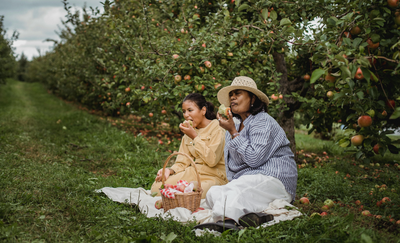You're Eating Too Much Sugar. What's at Risk when Breastfeeding?
You're Eating Too Much Sugar. What's at Risk when Breastfeeding?
By Katie Black
I’ll let you in on a little secret: the butt load more sugar we consume around the holidays is not why this post was written. We have a much bigger problem on our hands than the peppermint bark, eggnog, and gingerbread being passed around this time of year.
What we should be concerned about is how much sugar we eat 365 days of the year.
Did you know that women should be having 6 teaspoons or 24 grams max of added sugar daily? Guess how much women are actually consuming?
The majority of women in the United States are consuming far more on a regular basis. In fact, women in the US on average consume triple the daily maximum.
This is unhealthy for everybody, but when you’re breastfeeding the sugar gets passed into your breast milk too and can do irreversible harm to a nursing baby.
We’ll be focusing on fructose, a main component of added sugars like cane or corn syrup. It can have bad effects on both adults and kids—especially breastfeeding infants.
This is because while every cell can use glucose (the other component of sugar) only the liver can metabolize large amounts of fructose. Most scientists believe it’s the fructose in sugar instead of glucose that can be so harmful to our health. Moreover, human milk doesn’t naturally have fructose.
The dark history of sugar production and consumption in America
Sugarcane was first brought to the Americas by Christpher Coulmbus in 1493.
Sugar was expensive and only the elite and very wealthy could afford it. It required a lot of labor to make and the process was super dangerous at that time. Plus slavery was used for growing and making it.
In the 18th century, sugar plantations spread in the South, particularly in Louisiana, Florida, and the Caribbean. Boosted by industrialization, sugar mills used steam power and brutal enslavement. These changes made sugar more accessible and affordable to consumers. This is also when beet sugar production began.
During the American Civil War, sugar production was interrupted in the South and so the North began to cultivate it as well.
During the 20th century, the amount of sugar added to foods and drinks began rising. Soda, for example, was often used as a mixer for alcoholic drinks. But during Prohibition, many Americans started drinking soda by itself.
WWII also brought a sugar shortage and after it became readily available again, consumption took off.
Today you can find added sugar in just about every food you can think of. Companies use it to sell more products-even if they’re savory. We’re currently in the midst of what scientists call an obesity epidemic—and sugar plays a huge role.
Why do we crave sugar?
Not only does your brain release dopamine when you eat sugar, but there might be evolutionary reasons for sweet cravings too. Our ancestors relied on fruit for a lot of their energy needs. The riper (therefore sweeter) the fruit, the more energy it could give so the higher the chances of survival.
Sneaky added sugars
One of the most tricky sources of added sugar are foods we don’t think would have them. It’s annoying and takes a lot of time to check the ingredients for every item we pick up, but you’d be surprised at what’s actually in the foods we buy.



For example, there is often a significant amount of added sugar in things like:
- Bottled coffee and tea
- Breads
- Canned vegetables and beans
- Condiments like ketchup
- Nut butters
- Pasta sauces
- Salad dressings
- Soup
Try this: For one day keep track of all the added sugar in your meals. You might be surprised how quickly it adds up—even when you skip dessert or a sweet drink!
Little Treat Culture
A lot of the foods or drinks that used to be once-in-a-while treats have become a daily pick-me-up as a way to reward ourselves for handling another stressful day. Aggressive marketing is a major player in the way unhealthy lifestyles and diets are normalized.

Taking part in treat culture can even ward off loneliness and boredom. When you see content creators make a ritual of going out for their daily drink and sipping on their pumpkin spice latte, you feel like a part of a larger community when you stop by your own local Starbucks or “share a coke” with a friend.


Little treats are often framed as self-care, but if you think about it, consuming too much sugar on a daily basis is totally harmful to self care. Caring for oneself physically, mentally, and emotionally often means doing things you don’t want to do for the sake of your overall health and happiness.
This definitely doesn’t mean you should never reward yourself, or splurge on something just for you. Just be mindful when you’re getting a “little treat” and try to have sweet treats in moderation while breastfeeding.
Sugar in breast milk
There are sugars naturally in breast milk and they’re a necessary nutrient, but as for the excessive sugar a breastfeeding mom eats, studies are showing they can harm developing infants both physically and cognitively.
In 2020, this study from the American Journal of Clinical Nutrition looked at the association between moms consuming fructose, sugar sweetened beverages, and juice during lactation, and infant neurodevelopment at 24 months.
The researchers controlled for maternal age, BMI during pregnancy, education level, kilocalories, infant age, sex, and birthweight.
Put simply, the results found that the more fructose a mother drank when breastfeeding her one month old, the worse her child’s cognitive development scores were when they reached 24 months old.
This could be due to several reasons:
- Fructose induces oxidative stress in the frontal cortex.
- Fructose interferes with neurotrophins that regulate brain maturation.
- Fructose increases inflammatory mediators in the hippocampus.
These results show that too much fructose during key moments of brain development can harm the growth of systems in the parts of the brain responsible for cognition.
Plus, the study showed that moms who drink things with high-fructose corn syrup had more fructose in their breast milk.
Infant somatic growth is a way to measure growth and health in children. The measurements include body weight, body length, head circumference and ponderal index i.e. weight relative to height. Evidence from genetic studies shows that lower somatic growth scores increase human longevity. This means the more fructose, the higher somatic growth measurements, and thus a possible decrease in overall longevity.
There’s also evidence that the sugar moms consume while breastfeeding can affect other types of development in their babies. This study from 2017 in the journal Nutrients found a link between fructose consumed by moms while breastfeeding, and body fat in breastfeeding babies.
We all know that added sugar raises the risk for obesity plus related metabolic diseases like type 2 diabetes, cardiovascular disease and non-alcoholic fatty liver. Fructose seems to be at least partially to blame for this because of how it’s metabolized.
Moms in the study were excluded for tobacco use, drinking more than one alcoholic drink per week, type 1 or 2 diabetes before or during pregnancy, or the baby having any congenital birth defects.
Even after adjusting for baseline covariates (one-month infant weight, infant sex, and maternal BMI),
“breast milk fructose accounted for an additional 8% of the variance in infant weight, an additional 9% of the variance in infant lean mass, an additional 7% of the variance in infant fat mass, and an additional 9% of the variance in infant bone mineral content at 6 months of age.”
Each microgram (one millionth of a gram) per milliliter increase in fructose was associated with a 257 g increase in body weight, 170 gram increase in lean mass, 131 gram increase in fat mass, and 5 gram increase in bone mineral content. The researchers also noticed fructose levels predicted an increase in weight-for-length scores.
They didn’t find any evidence that infant growth was related to a mom’s pre-pregnancy BMI or to any of the other breast milk components.
More research is needed to see if it’s possible for very small amounts of fructose to affect musculoskeletal development plus adipose tissue development in infancy and early life. This is a time of rapid growth where major changes happen in muscular and skeletal growth.
What can you do?
Have you ever gone shopping with a friend and found they kept trying to convince you to buy things you don’t need? People often try to justify their own choices by convincing others to make the same. Same goes for alcohol and unhealthy foods.
The people that surround us can have a powerful influence on the decisions we make. So when we’re trying to live a healthier life, it’s important to have supportive people who won’t hold you back.
If you decide you want to cut back on sugar, let those you are close to know, and ask them not to offer you sweets or a soda when you hang out.
Another thing to keep in mind is that when it comes to sugar, it’s not a personal failing to crave it or struggle with cutting back. We’re surrounded by temptations both obvious and not and this is a systemic issue. Sometimes the treats we reach for are a substitution for a thriving social life or fulfilling career. They’re also at the center of many celebrations and events.
It’s in no way easy to limit sugar when it’s everywhere and in almost everything. One of the most effective first steps you can take when trying to change a habit is to start by simply observing your behaviors.
This means you don’t beat yourself up for eating that cookie, rather you pay attention to how you feel and what your thoughts are before, during, and after eating it. Over time you may notice patterns or certain triggers for your cravings, like you want something sweet and caffeinated when you’re stressed or tired.
Another thing to keep in mind is that it's much easier to replace a habit than cut one out altogether. So if you look forward to a daily latte and pastry from a local cafe, instead of stopping altogether see if you can tweak anything about the ritual like ordering your coffee with half the amount of sweetener and opting for a savory baked good instead.
And as with most unhealthy foods, consuming them in moderation is ok. Just try to keep track of the amount you’re regularly consuming, and if it’s too much, do what you can to cut back.
If you’re concerned or curious about the nutritional quality of your breast milk, you can get it tested here. Every test comes with personalized recommendations for optimizing your breast milk based on your results. This can be a great tool in helping you know your breast milk is more than enough.
other reads you'll like
Caffeine and Breast Milk: How Much is Safe?
Quick Guide to Alcohol and Breastfeeding + 4 Lactation Supporting Mocktails
Can You Breastfeed While Taking ADHD Medication?
sources
https://www.ncbi.nlm.nih.gov/pmc/articles/PMC5622030/
https://www.ncbi.nlm.nih.gov/pmc/articles/PMC5532289/
https://www.sciencedirect.com/science/article/pii/S0002916522009303?via%3Dihub
https://www.nytimes.com/interactive/2019/08/14/magazine/sugar-slave-trade-slavery.html






